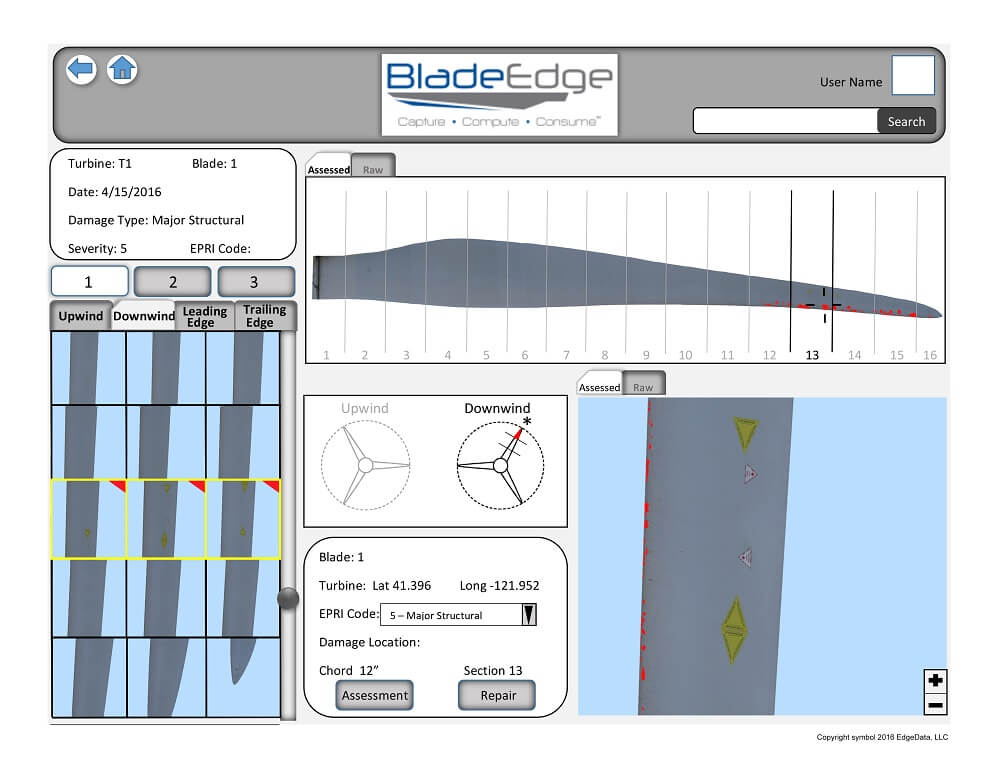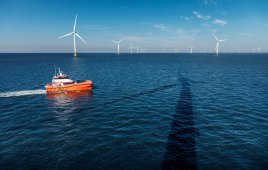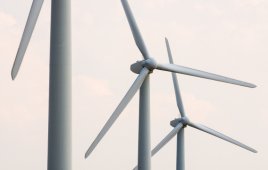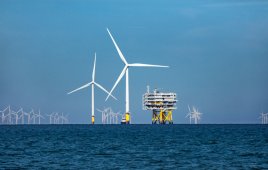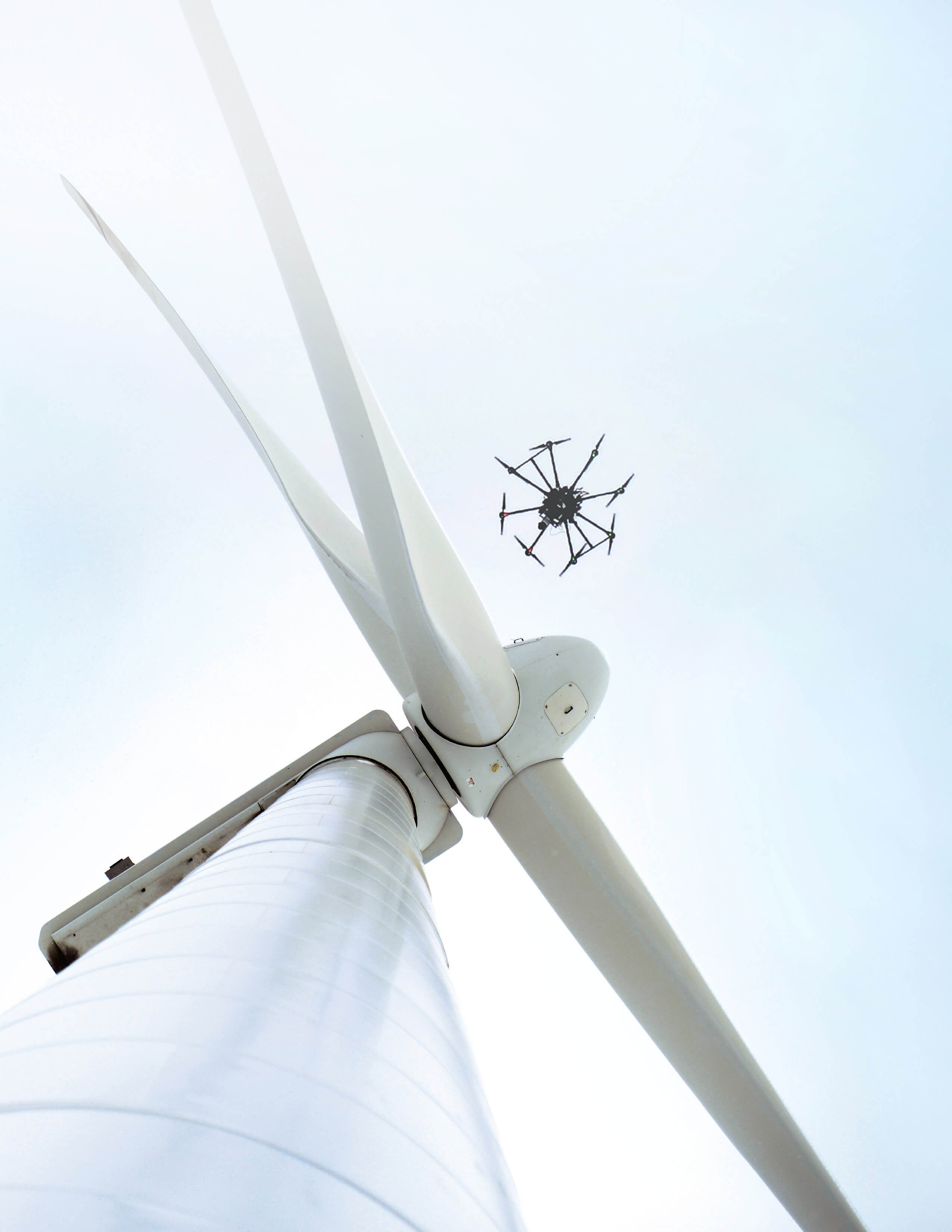
For the time being, most UAV inspection companies are focused on the blades but there is still opportunity to inspect more with the aircraft.
Drones or UAVs have ushered in a new era of blade and turbine inspections at wind farms. The speed and detail possible from a UAV inspection is impressive enough (three blades in an hour), but consider the safety and cost issues and you begin to sense an inevitable future. For the time being, most UAV inspection companies are focused on the blades but there is still opportunity to inspect more with the aircraft.
“One of our fundamentals is also to manage an enormous amount of data,” says Chris Shroyer, President of UAV inspection firm EdgeData. “That is, to present all of the associated data regarding the condition of the turbine. For that we devised a naming convention and file structure. It is important we maintain that structure from the beginning to the end of our process so the owner has organized data and actionable images. We’ve learned our lesson the hard way so we are well-attuned to the right way,” says Shroyer.
The raw images are 30 megabyte files. “Larger files are possible but we find 30 megabytes adequate. The presentation to the customer will be probably closer to five megs because you don’t want to ship so much data.” When they wish, clients can download a raw image. “They can access that level of detail when needed, but we’ve migrated towards the image quality you typical want to see in a browser, and that is about five megs,’ he adds.
Blades, of course, are enormous. So is it possible to see a picture of an entire blade instead of segments? “It is. We’re managing all of the image data along with the meta data behind each image. That data comes from the air frame, such as the gimbal that holds the sensor or camera. We can stitch all related images together to show a single view of the blade and all four sides because we have the data behind every image,” says Shroyer.
More importantly to wind techs is to pinpoint the blade damage. Damage at the tip means something different than damage at the root, and something closer to the leading edge or trailing edge is entirely different. “That’s the purpose of the full picture. We’re working on being able to take measurements of that data, such as the distance from the root to the damage, and how far from the trailing edge to the damage. We’re not quite there yet. We’re proving the capability for it, and will eventually integrate the feature into the software,” he says.
Setup time for an inspection is usually less than 15 minutes. “This is a reason to standardize on an air frame. The batteries are charged, and maintenance has been done on the system. When that is managed well, it’s a pretty quick setup,” says Shroyer. One battery provides 20 minutes of flight time.
An aerial inspection now takes less than an hour. “Today, we like to rotate the blades into a set position and a wind technician is needed for that. But we would still inspect three blades and all four sides of each in an hour.”
For the time being, the FAA requires that inspection crews are made of a drone pilot with a pilot’s license.
The pilot license sounds a bit unnecessary but Shroyer points out that drones are real aircraft. “Although the rule does seem a bit onerous when you’re in the middle of North Dakota. But when in downtown New York City, maybe not so much. Having a pilot’s skill makes sense when considering the sheer scale and perspectives of flying near a several hundred-meter tall wind turbine, getting the right angle on the image, descending the blade in a proper way, and being aware of obstacles such as the tower.”
That is a lot. “An inspection did not strike me as terribly complicated until I was on site for my first mission. What’s considered a fairly decent sized drone just disappears up among the blades. Knowing where the UAV is and having the observer help the pilot makes for good teamwork because there is a fair amount to manage. The observer also helps with data management, such as noting which blades are being captured on which turbine. There’s a challenge with all of that,” says Shroyer.
Still, raw images are available to clients the day of the flight. “However, it takes a few weeks for us to process and manually present through the software. Over time, we anticipate delivering a full report in probably 36 hours.”
Blades are the big focus for now but Shroyer’s team is also doing R&D. “We’re members of AWEA so we work with other organizations and manufacturers to understand the engineering aspects of the materials. We’ve looked at thermal conditions. We’ve looked at multi-spectral, hyper-spectral, and lidar as well. At this point, the RGB cameras and spacial images are providing us with the kind of data that really matter. I don’t think other sensors provide a lot of value yet. But there is potential.”
One area of opportunity might be to clean the blades of organic materials with a high-pressure wash. “Some drones now apply paint. But as you know, blades are really built today as a piece of art, and each one is individually constructed. I don’t see any time in the near future that the drones will displace the individual who makes repairs,” says Shroyer.
The more pressing issue is what to do with two thousand images. “We’re solving that now with the BladeEdge software. Let’s get the images into a system that can manage, organize, and use them in a simple dashboard. Then we’re adding a layer of analytics and such. That’s really our value add,” says Shroyer.
If cars can drive themselves, why not let the drones fly themselves for an inspection? “First regulatory and technology will have to catch up. And then the inspection would be more likely in less than 25 mph winds and in non-gusting conditions. The future we see is a UAV in a tech’s tool bag. That’s a few years out. Until we get to that point, we are required to have a pilot and an observer, and we will have to rotate the turbine blades for each inspection. We are still learning the steps of the process in a manual way. But over time, it’ll certainly become more autonomous,” he said.
Filed Under: O&M

